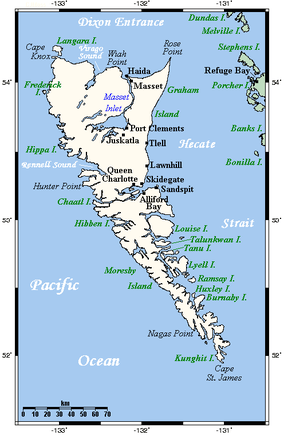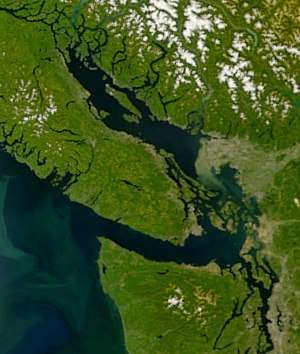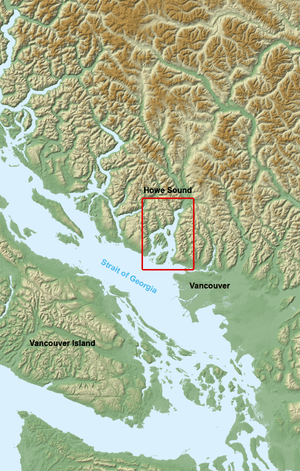British Columbia Coast
The British Columbia Coast or BC Coast is Canada's western continental coastline on the North Pacific Ocean. The usage is synonymous with the term West Coast of Canada.
In a sense excluding the urban Lower Mainland area adjacent to the Canada–United States border, which is considered "The Coast," the British Columbia Coast refers to one of British Columbia's three main regions, the others being the Lower Mainland and The Interior.
The aerial distance from Victoria on the Strait of Juan de Fuca to Stewart, British Columbia on the Alaska border at the head of the Portland Canal is 965 kilometres (600 mi) in length. However, because of its many deep inlets and complicated island shorelines—and 40,000 islands of varying sizes, including Vancouver Island and Haida Gwaii —the total length of the British Columbia Coast is over 25,725 kilometres (15,985 mi), making up about 10% of the Canadian coastline at 243,042 kilometres (151,019 mi).[1] The coastline's geography, which is shared with Southeast Alaska and adjoining parts of northwest Washington, is most comparable to that of Norway and its heavily indented coastline of fjords,[2] a landscape also found in southern Chile. The dominant landforms of the BC Coast are the Insular Mountains, comprising most of Vancouver Island and Haida Gwaii, and the Coast Mountains, which extend beyond into Alaska and the Yukon.
The British Columbia Coast is mostly part of the Pacific temperate rain forests ecoregion as defined by the World Wide Fund for Nature. In the system used by Environment Canada, established by the Commission for Environmental Cooperation (CEC), the area is defined as the Pacific Maritime Ecozone. In the geoclimatic zones system used by the British Columbia Ministry of Forests the bulk of the region comprises the Coastal Western Hemlock biogeoclimatic zone, although small areas flanking the Strait of Georgia at the coast's southern extremity are classed in the Coastal Douglas-fir zone.
History
Research from the 1990s has indicated that the Ice Age-era coastline of the British Columbia Coast was lower by about 100 metres (330 ft). The effect of the waterlevel on the coastline was such that the Queen Charlotte Strait, which is between Haida Gwaii and the northern end of Vancouver Island, was a coastal plain, as were all the straits inland from it, except for those that were mountain valleys.
Underwater archaeology has shown the presence of permanent human habitations and other activity at the 100-metre (330 ft) contour, and the Ice Age existence of such a coastal plain has put a new light on Ice Age populations in North America as well as on the strong likelihood of this area having been the major migration route from (and perhaps to) Asia.
The heavy indentation and mild climate of the British Columbia Coast have led to inevitable comparisons with the geography's predisposition to encouraging increased human settlement and movement as well as cultural foment and population growth in the Aegean, the Irish Sea/Hebrides and in the Danish Archipelago and adjoining Scandinavian coasts.
The natural fecundity of the environment—rich in seafood, game and greenery—combined with the ease of travel (by water) is seen in all cases (British Columbia, Denmark, Greece) to have generated a dynamic and gifted civilization. And there are comparisons to be made between the artistic and political and social level of the Pacific Northwest Peoples and those of pre-Conversion pagan Scandinavia, Ireland and Archaic-Era Greece.
Shipping, ferries, and sailing
Scheduled Passenger Services operating on the British Columbia Coast are dominated by BC Ferries and the Alaska Marine Highway.
BC Ferries, a privately managed Crown Corporation, operates major daily sailings between the Lower Mainland and Vancouver Island via three routes: Horseshoe Bay to Departure Bay, Tsawwassen, British Columbia to Swartz Bay, British Columbia, and Duke Point, British Columbia to Tsawwassen.
Dozens of smaller ferries ply lesser routes between the Gulf Islands and the mainland or Vancouver Island as well as on various lakes in the Interior where no bridges exist. Other runs connect Horseshoe Bay to the Sunshine Coast and Bowen Island and the lower Sunshine Coast to the Powell River section of that coast farther northwest. From there, a ferry operates to Comox.
BC Ferries also operates a sailing from Prince Rupert to Masset on Haida Gwaii as well as a major Inside Passage routing from Port Hardy on northern Vancouver Island to Prince Rupert and, in summer season, from Port Hardy to Bella Coola via several smaller coastal communities in between.
The Alaska Marine Highway operates regular ferry sailings from Bellingham, Washington to Ketchikan, Wrangell, Sitka, Juneau, Skagway, Haines and lesser ports-of-call in Southeast Alaska. The Alaska Marine Highway also operates a vessel from Prince Rupert to Ketchikan and other Southeast ports.
Other scheduled passenger services are run by various small shipping and water-taxi companies.
Non-scheduled passenger services include all major cruise lines and various small luxury craft charters, as well as shuttles to and from the various coastal resorts.
The Port of Vancouver is the largest commercial shipping port in the Pacific Northwest and Canada and is the largest on the West Coast of North America by metric tons of total cargo with 76.5 million metric tons[3] and is the fifth largest port in North America overall.[4]
Fishery
The fishery of the Pacific Northwest Coast is legendary, especially for its many salmon runs and the cultures that built on top of them throughout the region. Salmon runs have greatly diminished since pre-Contact years and the advent of commercial canning and, ultimately, depletion of stocks by high-seas fishing.
Other commercial fisheries include halibut, herring and herring roe, sea urchin and other specialty sushis, hake, haddock, cod, crab and shellfish.
Major inlets
The great fjords of the British Columbia Coast rival those of Norway in length and depth but have even higher mountain scenery with a more alpine flavour. Many of the islands offshore are much larger than those along the Norwegian coast, many large enough to have major fjords of their own, as well as their own mountain ranges. This is also of course even more true of the very large islands farther offshore, Vancouver Island and Graham and Moresby Islands in Haida Gwaii, which together form the Insular Mountains, distinct from the Coast Mountains of the mainland.
Here are the most important fjords, inlets, straits and sounds, including those important for reasons other than their size, listed south to north:
|
|
The many fjord-like waterways between the coast and the islands, and within the archipelago, cannot be fully listed here, and there are many more others that are not so much fjord-like as flooded valleys between what had been mountain peaks many thousands of years ago, when the shoreline was lower.
Major waterways
The waterway route through these islands between Vancouver and Prince Rupert, and between Seattle, Washington, and Alaska, is known as the Inside Passage. It has played a role in U.S.-Canada relations more than once, from the Klondike Gold Rush to the Salmon War of the 1990s.
Major and important waterways listed from south to north are:
|
On Vancouver Island south to north:
|
Major islands
 Map of Haida Gwaii | |
| Geography | |
|---|---|
| Location | Pacific Ocean |
| Coordinates | 53°N 132°W |
| Total islands | c. 150 |
| Major islands | Graham Island, Moresby Island |
| Area | 10,180 km2 (3,930 sq mi) |
| Highest elevation | 1,164 m (3,819 ft) |
| Highest point | Mount Moresby |
| Administration | |
Canada | |
| Province | British Columbia |
| Largest settlement | Queen Charlotte City (pop. 948) |
| Demographics | |
| Population | 4,761 [5] (2008) |
| Pop. density | 0.468/km2 (1.212/sq mi) |
| Additional information | |
| Time zone | |
North Coast
- Haida Gwaii (Queen Charlotte Islands)
- Porcher Island
- Pitt Island
- McCauley Island
- Banks Island
- Gil Island (Douglas Channel)
- Gribbell Island (Douglas Channel)
- Hawkesbury Island (Douglas Channel)
- Princess Royal Island
- Aristazabal Island
- Price Island
- Swindle Island
Central Coast
- Campbell Island (village of Waglisla)
- Denny Island (village of Bella Bella)
- Hunter Island
- King Island (Dean Channel)
- Calvert Island
- Caamano Island
- Malcolm Island (Sointula)
- Broughton Archipelago
- Broughton Island
- Gilford Island Knight Inlet
- West/East Cracroft Islands Knight Inlet
Johnstone Strait
- Hardwicke Island Johnstone Strait
- Discovery Islands
- East Thurlow Island
- West Thurlow Island
- Sonora Island
- Maurelle Island
- Read Island
- Raza Island
- Quadra Island
- Cortes Island
- East Redonda Island
- West Redonda Island
- Hernando Island
- Stuart Island
- Rendezvous Islands
- Nelson Island
Strait of Georgia

- Northern Gulf Islands:
- The southern Gulf Islands are as follows:
- Gabriola Island
- Valdes Island
- Thetis Island
- Kuiper Island
- Saltspring Island
- Prevost Island
- Galiano Island
- Mayne Island
- North Pender Island
- South Pender Island
- Saturna Island
- Sidney Island
- James Island
The Gulf Islands continue southeast across the Haro Straits as the San Juan Islands.
Howe Sound and Fraser River Islands

The islands of Howe Sound are classed among the southern Gulf Islands, but they adjoin the mainland rather than Vancouver Island and are usually considered separately. They are:
- Bowen Island
- Gambier Island
- Anvil Island (Hat Island)
- Keats island
- Bowyer Island
The islands of the Fraser River estuary are:
- Barnston Island (unincorporated agricultural community)
- Lulu Island (City of Richmond)
- Sea Island (YVR Vancouver Airport)
- Westham Island (wildfowl refuge)
- Iona Island (Vancouver sewage treatment plant)
- Deas Island (Hwy 99 tunnel beneath the Fraser)
- Annacis Island
Coastal communities
|
|
Resorts and fishing lodges
- Yellow Point Lodge, Nanaimo
- Painter's Lodge, Desolation Sound
British Columbia Coastal First Nations
First nation communities are listed south to north.
|
Lower Mainland and lower Sunshine Coast
Greater Victoria
South Central Vancouver Island Central Vancouver Island and upper Sunshine Coast
Vancouver Island West Coast
|
Northern Vancouver Island and Central Coast
North Coast and Northwestern British Columbia
|
Parks and preserves
|
|
See also
- Insular Mountains
- Coast Mountains
- Inside Passage
- Oregon boundary dispute
- Alaska Boundary Dispute
- Southeast Alaska
- Dixon Entrance
- A-B Line
- History of the west coast of North America
References
- Sebert, L.M., and M. R. Munro. 1972. Dimensions and Areas of Maps of the National Topographic System of Canada. Technical Report 72-1. Ottawa: Department of Energy, Mines and Resources, Surveys and Mapping Branch.
- Steph Glinski (1 September 2013). "Journey to Canada's Secret Sunshine Coast". BBC. Retrieved 16 May 2015.
- "World Port Rankings - 2005" Archived September 27, 2007, at the Wayback Machine - Port Industry Statistics - American Association of Port Authorities (AAPA) - Updated May 1, 2007 - (Microsoft Excel *.XLS document)
- "North American Port Container Traffic - 2006" Archived 2008-12-19 at the Wayback Machine - Port Industry Statistics - American Association of Port Authorities (AAPA) - Updated May 14, 2007 - (Adobe Acrobat *.PDF document)
- "Population Estimates". bcstats.gov.be.ca. Archived from the original on 22 July 2012. Retrieved 28 October 2010.
| Wikimedia Commons has media related to Coast of British Columbia. |